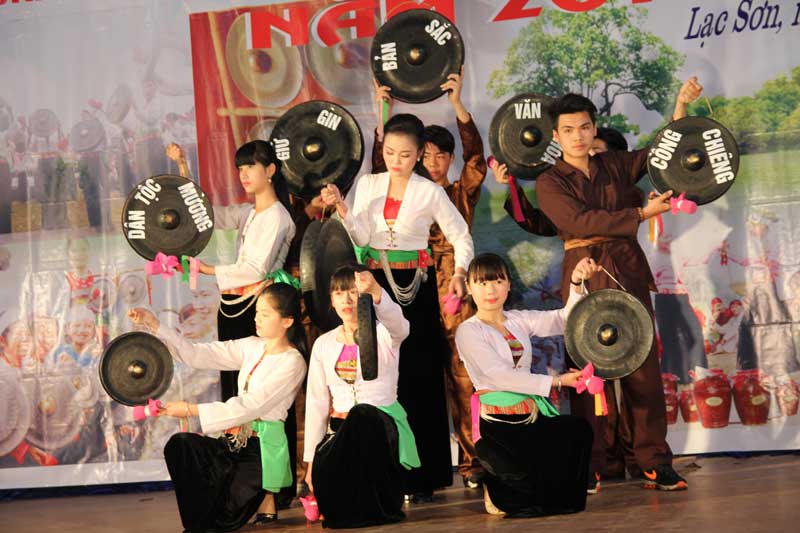


 Over the past years, the performance of
Muong Gong and ethnic costumes have always been paid attention to, contributing
to preserving and promoting the traditional cultural values.
Over the past years, the performance of
Muong Gong and ethnic costumes have always been paid attention to, contributing
to preserving and promoting the traditional cultural values.
The district has been paying a special attention to preserving and developing the cultural values of Muong ethnic people in the customs, beliefs and daily life of the people. Lac Son is a district that still retains more than 3,000 gongs and a lot of communes such as Nhan Nghia, An Nghia, Tan Lap and 100% of the hamlets have the gong performance teams. In particular, the district has been implementing a plan to selectively preserve, conserve, inherit and promote the value of Mo Muong and the preservation of the artistic heritage of Thuong Rang – Bo Meng- Dum singing of Muong ethnic people. According to this, there are specific plans and solutions for managing, conserving, and associating with the development of community tourism in localities at the same time.
The district has been focusing on preserving and maintaining the traditional festivals such as the festival of Coi communal house in Vu Binh commune, the Buddha procession in Khu Dung cave, Nhân Nghĩa commune, the festival of coming to the fields in Yen Phu commune, the festival of Lime swing in Vu Ban town, the festival of Cay Da temple in Vu Ban town. A ceremony to receive 4 certificates of the recognition of the provincial-level historical and cultural relics has been held. They include Cay Si temple, Truong Kha temple, Thuong temple (Vu Ban town), Mau temple (Vu Binh commune) and 1 provincial-level landscape, Mu Falls in Tu Do commune.The brocade weaving has been developing in Luc hamlet, Yen Nghiep commune. The rattan and bamboo knitting have also been developing in Bui hamlet, Nhan Nghia commune. They both help preserve the traditional cultural values and create jobs for the local laborers. The district has been implementing the plan to organize the Independence New Year on the occasion of the August Revolution and the National Day, September 2 in order to conserve and encourage the people to participate in preserving and developing the good traditional cultural values.
In addition to the rich culture of Muong ethnic identity that is preserved and developed, Lac Son's vast land with the beautiful landscapes, the primeval forests, many waterfalls are valuable tourism resources being paid attention to explore. Thung Hill in Quy Hoa commune with the dreamy layered terraced fields, the cool climate, and the hot mineral springs, which is a great potential for developing eco-tourism and convalescence is located at an altitude of over 1,000 m. Ngoc Son - Ngon Luong Nature Reserve, Bai Nha peak (Ngoc Son commune) used to be the venue for Vietnam paragliding tournament. The spectacular and dreaming Mu waterfall (Tu Do commune) is a destination for tourists from near and far. The district also has many famous agricultural products, such as Lac Son chicken, Doi seeds of Chi Dao, Tu Do honey taken from forests, etc., which make an important contribution to the the local sustainable poverty reduction for people.